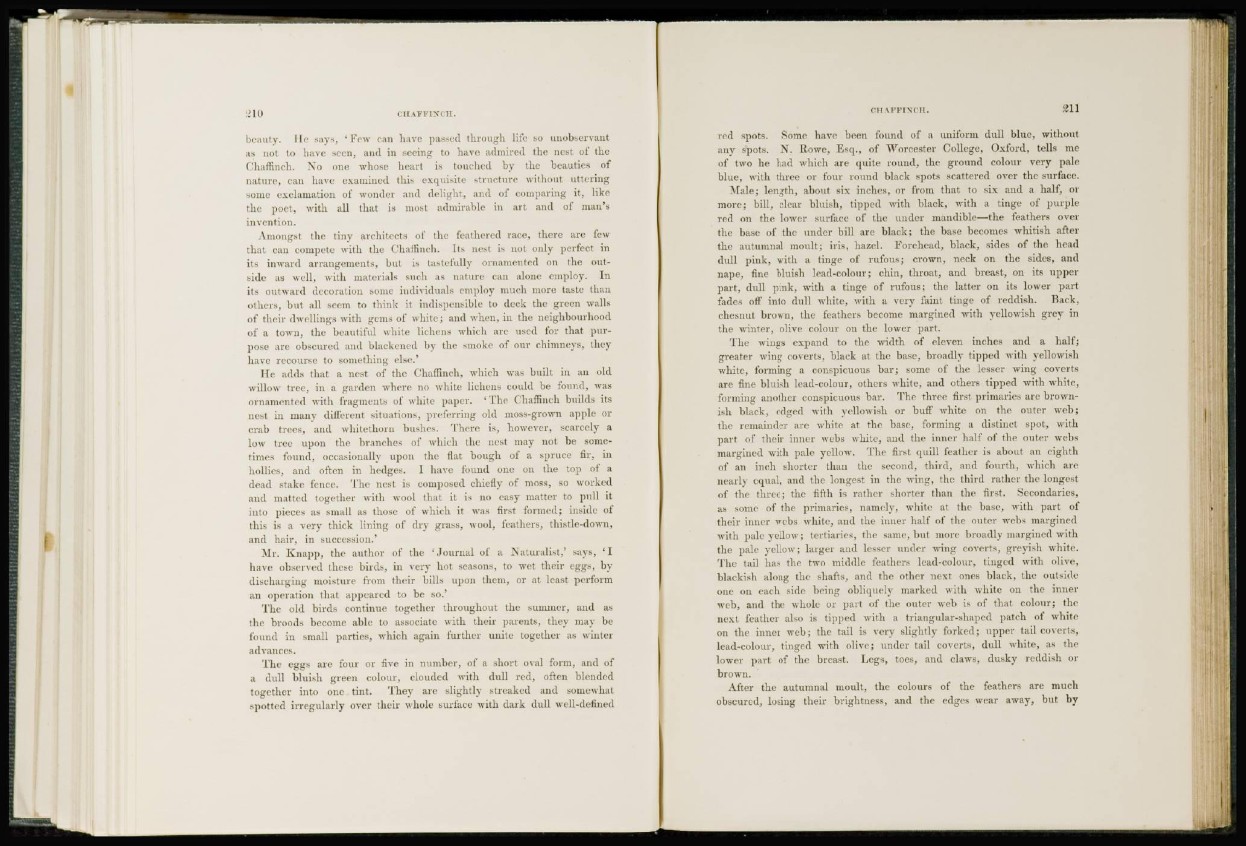
beauty. He says, 'Few can have passed through life so unobservant
as not to have seen, and in seeing to have admired the nest of the
Chaffinch. No one whose heart is touched bv the beauties of
nature, can have examined this exquisite structure without uttering
some exclamation of wonder and delight, and of comparing it, like
the poet, with all that is most admirable in art and of man's
invention.
Amongst the tinv architects of the feathered race, there are few
that can compete with the Chaffinch. Its nest is nut only perfect in
iis inward arrangements, but is tastefully ornamented on the outside
as well, with materials such as nature can alone employ. In
its outward decoration some individuals employ much more taste than
others, but all seem to think it indispen>ible to deck the green walls
of their dwellings with gems of white; and when, in the neighbourhood
of a town, the beautiful white lichens which are used for that purpose
are obscured and blackened by the smoke of our chimneys, they
have recourse to something else.*
He adds that a nest of the Chaffinch, which was built in an old
willow tree, in a garden where no white lichens could be found, was
ornamented with fragments of white paper. "The Chaffinch builds its
nest in many different situations, preferring old moss-grown apple or
crab trees, and whitethorn bushes. There is, however, scarcely a
low tree upon the branches of which the nest may not be sometimes
found, occasionally upon the flat bough of a spruce fir, in
hollies, and often in hedgps. I have found one on the top of a
dead stake fence. The nest is composed chiefly of moss, so worked
and matted together with wool that it is no easy matter to pull it
into pieces as small as those of which it was first formed; inside of
this is a very thick lining of dry grass, wool, feathers, thistle-down,
and hair, in succession.'
Mr. Knapp, the author of the 'Journal of a Naturalist,' says, 'I
have observed these birds, in very hot seasons, to wet their eggs, by
discharging moisture from their bills upon them, or at least perform
an operation that appeared to be so.'
The old birds continue together throughout the summer, and as
the broods become able to associate with their parents, they may be
found in small parties, which again further unite together as winter
advances.
The eggs arc four or five in number, of a short oval form, and of
a dull bluish green colour, clouded with dull red, often blended
together into one tint. They are slightly streaked and somewhat
spotted irregularly over their whole surface with dark dull well-defined
('11 \FFTNCTI. !>11
r e d -.puts. Some have been found of a uniform dull blue, without
any spots. N. Rowe, Esq., of Worcester College, Oxford, tells me
of two he had which arc quite round, the ground colour very pale
blue, with three or four round black spots scattered over the surface.
Male; length, about six inches, or from that to six and a half, or
more; bill, clear bluish, tipped with black, with a tinge of purple
red on the lower surface of the under mandible—the feathers over
the base of the under bill arc black; the base becomes whitish after
the autumnal moult; iris, hazel. Forehead, black, sides of the head
dull pink, with a tinge of rufous; crown, neck on the sides, and
nape, fine bluish lead-colour; chin, throat, and breast, on its upper
part, dull pink, with a tinge of rufous; the latter on its lower part
fades off into dull white, with a very faint tinge of reddish. Rack,
chesnut brown, the feathers become margined with yellowish grey in
the winter, olive colour on the lower part.
The wings expand to the width of eleven inches and a half;
greater wing coverts, black at the base, broadly tipped with yellowish
white, forming a conspicuous bar; some of the lesser wing coverts
are fine bluish lead-colour, others white, and others tipped with white,
forming another conspicuous bar. The three first primaries arc brownish
black, edged with yellowish or buff' white on the outer web;
the remainder arc white at the base, forming a distinct spot, with
part of their inner webs white, and the inner half of the outer webs
margined with pale yellow. The first quill feather is about an eighth
of an inch shorter than the second, third, and fourth, which are
nearly equal, and the longest in the wing, the third rather the longest
of the three; the fifth is rather shorter than the first. Secondaries,
as some of the primaries, namely, whiter at the base, with part of
their inner webs white, and the inner half of the outer webs margined
with pale yellow; tertiaries, the same, but more broadly margined with
the pale yellow; larger and lesser under wing coverts, grevish white.
The tail has the two middle feathers lead-colour, tinged with olive,
blackish along the shafts, and the other next ones black, the outside
one on each side being obliquely marked with white on the inner
web, and the whole or part of the outer web is of that colour; the
next feather also is tipped with a triangular-shaped patch of white
on the inner web; the tail is very slightly forked; upper tail coverts,
lead-colour, tinged with olive; under tad coverts, dull white, as the
lower part of the breast. Legs, toes, and claws, dusky reddish or
brown.
After the autumnal moult, the colours of the feathers are much
obscured, losing their brightness, and the edges wear away, but by